Access available during daylight hours
Facilities
- Car park
Restrictions
- No toilet facilities
Access available during daylight hours
Grianán of Aileach is a state-owned National Monument in the care of the Office of Public Works
*The available car park is in the care of Donegal County Council*
WARNING: It should be noted that these sites are unguided and a level of care and caution should be maintained during all stages of your visit. The Office Of Public Works (OPW) will not be held responsible for any damages, injuries, or losses that occur
Standing on the summit of Greenan Mountain, the great stone fort known as the Grianán of Aileach commands spectacular views across Inishowen between Loughs Foyle and Swilly, west towards Letterkenny and east towards Derry where St Colum Cille’s foundation was the ecclesiastical powerhouse of the region. It has been suggested that the fort was originally constructed sometime before AD800 by the ambitious Áed Oirdnide, king of Cenél nÉogain, a small kingdom previously confined to the Inishowen peninsula. From the summit of Greenan Mountain he could view both his Inishowen homeland and gaze out over his newly won territories across Donegal and beyond. In this way, the Grianán of Aileach was very much a political statement. As the Cenél nÉogain continued to expand throughout Ulster, they invariably referenced the Grianán of Aileach as the stronghold of their royal authority in the region.
In 1101 AD Muirchertach Ua Briain, king of Munster, led a six-week military campaign deep into Ulster. His aim was to confront Domnall Mac Lochlainn (of Cenél nÉogain descent), the most powerful king in the north. If he was successful, he would emulate his great grandfather Brian Bórama (Brian Boru) to become the undisputed high king of all Ireland. His army headed for north Donegal and the Grianán of Aileach, then a symbol of Mac Lochlainn power throughout the region. However, Muirchertach’s ambition would be unfulfilled. Domhnall refused to engage the invading army in battle and never submitted to Muirchertach and recognise him as high-king. Instead, Muirchertach set about decommissioning the fortress that year when he ordered his army to carry away stones from the rampart (Annals of the Four Masters).
It is said that the origins of this impressive fort hark back to the Tuatha de Danánn - a mythical race with supernatural abilities - who would later become known as the Fae Folk. It is closely associated with the Dagda (the Good God), one of the godly leaders of the Tuatha. After his son Aodh was killed, the Dagda had a stone fort (now known as Grianán of Aileach) built as the burial place. The Metrical Dindshenchas, an early Irish text revealing the origins of place names, refers to this mythological tale: "A lovely spot is Ailech Gabráin, green are its boughs, on its sod the Dagda, famed in song, found a dwelling for Aed."
The interior of the circular fort measures some 23m across. At the east, a lintel-covered entrance passage extends through the thickness of the massive encircling wall, which is the only means of accessing the interior of the fort. This dry-stone wall stands some 5m high and incorporates a series of terraces that are accessed by stone steps. Two wall-passages, one from the south and another from the north-east, run towards the eastern entrance-passage. The remains of a rectangular building within the fort, recorded in the early 19th century, was reputedly a penal chapel, though it may have been a dwelling . Today there are no obvious traces of this structure.
The stone fort is probably the latest, and most obvious, of a series of defences on the hilltop. For example, it is located near the centre of a prehistoric hillfort comprising two closely spaced concentric banks and shallow ditches enclosing an oval area (75m x 65m) around the stone fort. Outside this is an even larger hillfort comprising two further banks that again are quite closely spaced and enclose a large quadrilateral area of the hilltop, some 140m x 135m across. It is quite likely that the hillforts were constructed in two different phases. A possible ancient roadway approaches the summit of the hill through a gap in the hillfort earthworks on the east-north-east side. At the southeast a small stone cairn, perhaps a burial monument from the Neolithic or Early Bronze Age, was recorded in the early 19th century, but this is difficult to identify on the ground today.
To the south of the fort is a spring well that is traditionally dedicated to St Patrick. This connection is reflected in The Tripartite Life of Patrick which records that the saint ‘went to Aileach of the Kings, and blessed the fortress, and left his flagstone there, and prophesised that kings and ordained persons out of Aileach would be over Ireland’.
Stone forts such as the Grianán of Aileach are seen as an archetypal secular monument from early medieval Ireland, however, such large stone forts are quite rare. One of the nearest examples is Doon Fort on an island in Doon Lough near Portnoo. Other examples in State Care can be found on the Aran Islands, including Dún Chonchúir on Inis Meáin and Dún Formna on Inis Oír and Dún Eochla on Inis Mór while in the southwest is Staigue Fort, Co. Kerry.
Protect our Past - Click here to read about the importance of protecting our country’s unique heritage sites
This national monument is protected in accordance with the National Monuments Acts 1930 to 2014
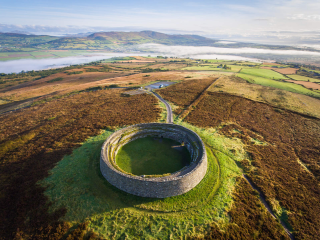
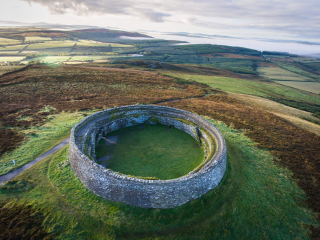
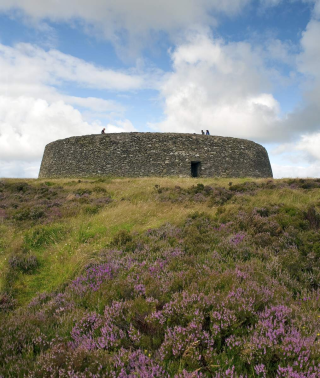
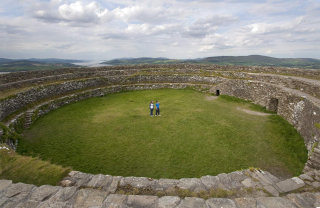
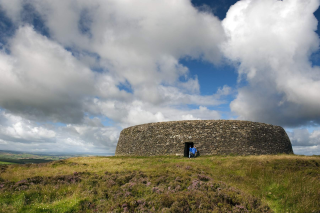

Delve into Ulster’s industrial heritage
Approx. 26.5 km from Grianán of Aileach
Explore a world-class collection of art
Approx. 30.4 km from Grianán of Aileach
A waterside citadel with a thrilling history
Approx. 30.4 km from Grianán of Aileach